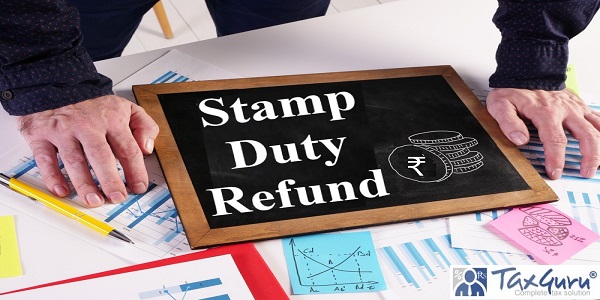Stamp duty is a significant expense incurred during property transactions, serving as a tax levied on legal documents related to the transfer of assets. However, there are instances where a refund of the paid stamp duty becomes necessary, such as when a transaction is canceled or deemed void. This comprehensive guide delves into the intricacies of the stamp duty refund process, particularly focusing on Maharashtra, India. We will explore the application procedure, required documentation, time limits, and provide insights to ensure a smooth refund experience.
Understanding Stamp Duty Refund
A stamp duty refund pertains to the reimbursement of the stamp duty paid on legal documents when certain conditions are met. Common scenarios warranting a refund include:
- Cancellation of Agreement: When a property transaction is canceled mutually by the parties involved.
- Void Transactions: If a transaction is declared void or illegal from the outset.
- Unused Stamps: Stamp papers purchased but not utilized for any transaction.
Eligibility Criteria for Stamp Duty Refund

To be eligible for a stamp duty refund, applicants must satisfy specific conditions:
- Timely Application: Applications must be submitted within the stipulated time frame from the date of the original transaction or registration.
- Valid Grounds: The reason for seeking a refund should align with the acceptable grounds defined by the authorities, such as cancellation or voidance of the agreement.
- Proper Documentation: Submission of all necessary documents to substantiate the claim.
Time Limits for Stamp Duty Refund Application
The time frame to apply for a stamp duty refund varies based on jurisdiction and specific circumstances. In Maharashtra:
- Standard Refund Period: Applications should be filed within six months from the date of the transaction or registration.
- Extended Period for Cancellations: In cases where the agreement is canceled, the refund application can be made up to two years from the date of registration.
It’s imperative to adhere to these timelines to ensure the eligibility of the refund claim.
Stamp Duty Refund Process in Maharashtra
The Government of Maharashtra has streamlined the stamp duty refund process to facilitate ease of access for citizens. The procedure involves both online and offline components:
-
Online Application Submission
Applicants are encouraged to initiate the refund process through the official online portal. The steps include:
- Access the Refund Portal: Visit the https://igrmaharashtra.gov.in/Home/stamp_duty_refund_about
- Agree to Terms: Read and accept the terms and conditions to proceed.
- New Entry: Select the option to create a new refund application.
- Generate Refund Token: Upon entering initial details, a unique Refund Token Number is generated. Applicants must set a password for this token.
- Enter Applicant Details: Provide personal and address information accurately.

- Stamp Purchaser Details: Input details of the stamp purchaser, including bank account information for refund credit.
- Stamp Details: Specify the type of stamp and related particulars. Multiple stamps can be added if applicable.
- Document Details: State the reason for the refund and indicate whether the document was registered or unregistered.
- Upload Required Documents: Attach all necessary documents in PDF format, ensuring each file is less than 100 KB.
- Acknowledge and Submit: Review the entered information, download the acknowledgment, and submit the application.
-
Physical Submission of Documents
After completing the online application, applicants must submit physical copies of the documents to the designated Collector of Stamps office:
- Prepare Documents: Assemble all required documents as per the checklist.
- Visit the Collector’s Office: Submit the documents along with the acknowledgment receipt from the online application.
- Verification Process: The office will verify the submitted documents and process the refund accordingly.
Documents Required for Stamp Duty Refund
Accurate documentation is crucial for the successful processing of a stamp duty refund. The typical documents include:
- Application Form: Duly filled and signed refund application form.
- Affidavit: Notarized affidavit stating the reason for the refund claim.
- Original Agreement/Deed: The original document for which stamp duty was paid.
- Cancellation Deed: If applicable, the deed indicating the cancellation of the agreement.
- Proof of Unused Stamps: In cases of unused stamp papers, provide the original unused stamps.
- Bank Details: Canceled cheque or first page of the passbook showing the applicant’s name, bank account number, and IFSC code.
- Identity Proof: Copies of PAN card, Aadhaar card, or other valid identity proofs.
- Payment Proof: Copy of the challan or receipt evidencing the payment of stamp duty.
Processing Time and Status Tracking
The duration for processing a stamp duty refund can vary based on the complexity of the case and the efficiency of the verification process. Applicants can monitor the status of their refund application through the following steps:
- Access the Refund Status Portal: Visit the Refund Status Check Page.
- Enter Credentials: Input the Refund Token Number, password, and captcha code.
- View Status: Click on ‘View Status’ to see the current stage of the application.
Regularly checking the status helps in staying informed about any additional requirements or updates.
Key Considerations and Tips
- Adhere to Time Limits: Ensure that the application is submitted within the prescribed time frame to avoid rejection.
- Accurate Information: Double-check all entered details and documents for accuracy to prevent delays.
- Keep Copies: Maintain copies of all submitted documents and acknowledgments for future reference.
- Seek Professional Assistance: If uncertain about any aspect of the process, consider consulting a legal professional or a consultant specializing in stamp duty matters.
Conclusion
Navigating the stamp duty refund process requires a thorough understanding of the applicable procedures, timely action, and meticulous documentation. By adhering to the guidelines outlined in this comprehensive guide, applicants can enhance the likelihood of a successful refund claim. Staying informed and proactive is key to ensuring that the refund process is as seamless and efficient as possible.
For more insightful articles on property-related topics, visit Housiey.
Explore our detailed blog on “Aamir Khan’s House” to get an exclusive glimpse into the Bollywood superstar’s residence.
FAQS
Stamp duty is a significant expense incurred during property transactions, serving as a tax levied on legal documents related to the transfer of assets. However, there are instances where a refund of the paid stamp duty becomes necessary, such as when a transaction is canceled or deemed void. This comprehensive guide delves into the intricacies of the stamp duty refund process, particularly focusing on Maharashtra, India. We will explore the application procedure, required documentation, time limits, and provide insights to ensure a smooth refund experience.
Understanding Stamp Duty Refund
A stamp duty refund pertains to the reimbursement of the stamp duty paid on legal documents when certain conditions are met. Common scenarios warranting a refund include:
- Cancellation of Agreement: When a property transaction is canceled mutually by the parties involved.
- Void Transactions: If a transaction is declared void or illegal from the outset.
- Unused Stamps: Stamp papers purchased but not utilized for any transaction.
Eligibility Criteria for Stamp Duty Refund

To be eligible for a stamp duty refund, applicants must satisfy specific conditions:
- Timely Application: Applications must be submitted within the stipulated time frame from the date of the original transaction or registration.
- Valid Grounds: The reason for seeking a refund should align with the acceptable grounds defined by the authorities, such as cancellation or voidance of the agreement.
- Proper Documentation: Submission of all necessary documents to substantiate the claim.
Time Limits for Stamp Duty Refund Application
The time frame to apply for a stamp duty refund varies based on jurisdiction and specific circumstances. In Maharashtra:
- Standard Refund Period: Applications should be filed within six months from the date of the transaction or registration.
- Extended Period for Cancellations: In cases where the agreement is canceled, the refund application can be made up to two years from the date of registration.
It’s imperative to adhere to these timelines to ensure the eligibility of the refund claim.
Stamp Duty Refund Process in Maharashtra
The Government of Maharashtra has streamlined the stamp duty refund process to facilitate ease of access for citizens. The procedure involves both online and offline components:
-
Online Application Submission
Applicants are encouraged to initiate the refund process through the official online portal. The steps include:
- Access the Refund Portal: Visit the https://igrmaharashtra.gov.in/Home/stamp_duty_refund_about
- Agree to Terms: Read and accept the terms and conditions to proceed.
- New Entry: Select the option to create a new refund application.
- Generate Refund Token: Upon entering initial details, a unique Refund Token Number is generated. Applicants must set a password for this token.
- Enter Applicant Details: Provide personal and address information accurately.

- Stamp Purchaser Details: Input details of the stamp purchaser, including bank account information for refund credit.
- Stamp Details: Specify the type of stamp and related particulars. Multiple stamps can be added if applicable.
- Document Details: State the reason for the refund and indicate whether the document was registered or unregistered.
- Upload Required Documents: Attach all necessary documents in PDF format, ensuring each file is less than 100 KB.
- Acknowledge and Submit: Review the entered information, download the acknowledgment, and submit the application.
-
Physical Submission of Documents
After completing the online application, applicants must submit physical copies of the documents to the designated Collector of Stamps office:
- Prepare Documents: Assemble all required documents as per the checklist.
- Visit the Collector’s Office: Submit the documents along with the acknowledgment receipt from the online application.
- Verification Process: The office will verify the submitted documents and process the refund accordingly.
Documents Required for Stamp Duty Refund
Accurate documentation is crucial for the successful processing of a stamp duty refund. The typical documents include:
- Application Form: Duly filled and signed refund application form.
- Affidavit: Notarized affidavit stating the reason for the refund claim.
- Original Agreement/Deed: The original document for which stamp duty was paid.
- Cancellation Deed: If applicable, the deed indicating the cancellation of the agreement.
- Proof of Unused Stamps: In cases of unused stamp papers, provide the original unused stamps.
- Bank Details: Canceled cheque or first page of the passbook showing the applicant’s name, bank account number, and IFSC code.
- Identity Proof: Copies of PAN card, Aadhaar card, or other valid identity proofs.
- Payment Proof: Copy of the challan or receipt evidencing the payment of stamp duty.
Processing Time and Status Tracking
The duration for processing a stamp duty refund can vary based on the complexity of the case and the efficiency of the verification process. Applicants can monitor the status of their refund application through the following steps:
- Access the Refund Status Portal: Visit the Refund Status Check Page.
- Enter Credentials: Input the Refund Token Number, password, and captcha code.
- View Status: Click on ‘View Status’ to see the current stage of the application.
Regularly checking the status helps in staying informed about any additional requirements or updates.
Key Considerations and Tips
- Adhere to Time Limits: Ensure that the application is submitted within the prescribed time frame to avoid rejection.
- Accurate Information: Double-check all entered details and documents for accuracy to prevent delays.
- Keep Copies: Maintain copies of all submitted documents and acknowledgments for future reference.
- Seek Professional Assistance: If uncertain about any aspect of the process, consider consulting a legal professional or a consultant specializing in stamp duty matters.
Conclusion
Navigating the stamp duty refund process requires a thorough understanding of the applicable procedures, timely action, and meticulous documentation. By adhering to the guidelines outlined in this comprehensive guide, applicants can enhance the likelihood of a successful refund claim. Staying informed and proactive is key to ensuring that the refund process is as seamless and efficient as possible.
For more insightful articles on property-related topics, visit Housiey.
Explore our detailed blog on “Aamir Khan’s House” to get an exclusive glimpse into the Bollywood superstar’s residence.
FAQS






